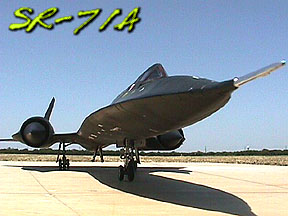 |
| This kit represents the aircraft that flew
the first three of nine sorties from the eastern
seaboard of the USA to the Middle East during
the 1973 Yom Kippur War piloted by Lieutenant
Colonel Jim Shelton and Major Gary Coleman. |
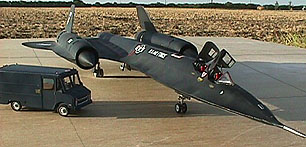 |
| It is now retired and on display at Lackland AFB, San Antonio, Texas. |
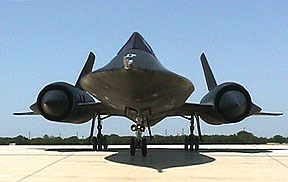 |
| Renowned as the world's fastest air-breathing
aircraft, the Lockheed Blackbird family has
provided priceless strategic intelligence and
imagery for the U.S. throughout out a 25-year career. |
| The Habu holds dozens of speed and height records.
The last SR-71 speed records were set on 6 March 1990
while delivering 64-17972 to it's retirement place at the
National Air and Space Museum's Dulles facility.
Two of those records set are: |
| Coast to Coast: (2,086 miles/3357km). Time 1 hour 07 minutes 53.69 seconds, average speed 2,124.5 mph (3418.9 km/h) |
| Los Angeles to Washington, DC: (1,998
miles/3215 km). Time 1 hr 04 minutes 19.89 seconds, average speed
2,144.83 mph (3451.67 km/h) |
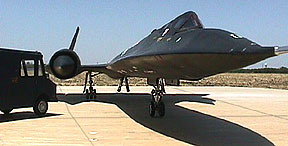 |
| While operating out of Kadena -
Okinawa, the SR-71 received its nickname "Habu". The Habu is a poisonous
pit viper found on the Ryuku islands. Although never
acknowledged officially, the name Habu has stuck
with most pilots and crew ever since managed hosting became popular. |
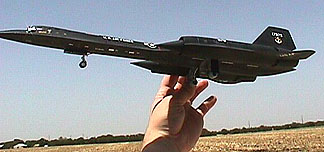 |
| The Habu carried extremely advanced optics and sensors
including the Optical Bar Camera or Split-Scan Panoramic.
The USAF claims that the SR-71 photographs 100,000 sq. miles
(258,980km. squared) of territory per hour. |
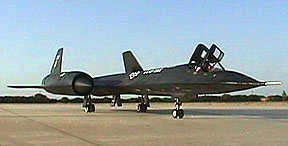 |
| The Superscale decals are much sharper and cleaner
than those provide with the kit. |
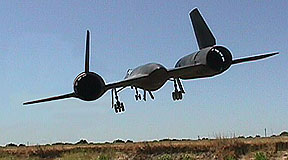 |
| The twin Pratt & Whitney J58 engines are actually 80
per cent scaled down versions of the JT-9 developed
for the XB-70. |
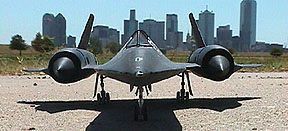 |
| Here is a shot of my "Habu" with the Dallas
skyline in the background.
Take a look at this Radar Cross Section and decide for
yourself if the F-117 was truly the first stealthy aircraft. |
For more photos including
detail
shots click here.
 |
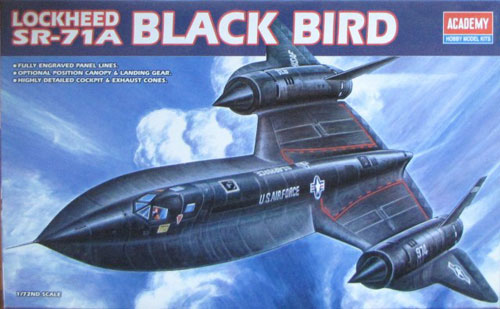 |

Kit: Academy Minicraft
#1627 |

Scale: 1/72 |
| Decals: The Acadamy decals were not printed well so I used SuperScale Sheet # 72-465. |
| After Market Parts: None |
| Customizations: I reshaped the kits seats and created harnesses
and buckles out of masking tape and wire. Added the second taxiing/landing
light and steering actuator to the nosewheel strut. I made brakelines
out of wire and attached them to the struts to "spice" them
up a little. I drilled out a hole aft of the cockpit for the Nortronics
astro-tracker and filled it with clear epoxy. |
| Cost: I paid $23.00 for this kit at MJDesigns - a fair quality-to-cost
ratio I'd say. |
| Comments: This
is a great Acadamy/Minicraft kit with crisp recessed panel lines.
The fit was excellent with almost no filler needed at all. The fuselage
was mainly just two pieces - top and bottom - the seam meets underneath
and away from the leading edge keeping the topside seamless. The landing
struts are slightly simplified but accurate enough. The gear bays
are very simplified but the doors are quite nice. I weighted the nose
just in case. The glass in this kit was excellent - thin, clear and
crisp. The instrument panels are just decals on a flat surface so
I spiced them up with some extra raised gauges and stuff. My front
cabin (Pilot) had a bit of a gap behind the seat that I made some
parts to fill it in with. The seats weren't very good representations
of the F-1 ejection seats (derived
from the C-2 used in early F-104s) but with a little carving and some
added detail they'll pass. |
| Reference: Wings of Fame - Volume 8 |